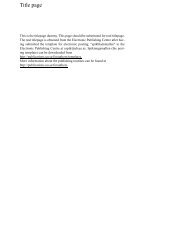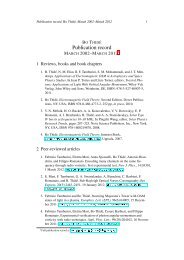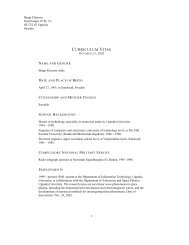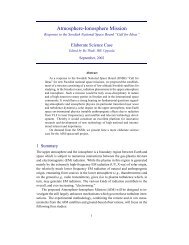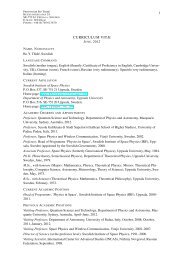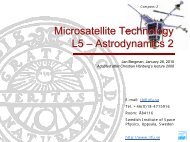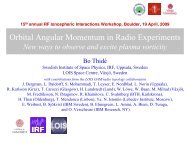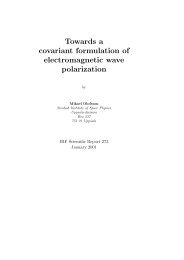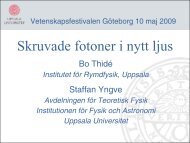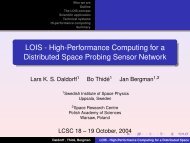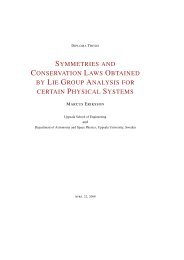lofar - Swedish Institute of Space Physics - Uppsala
lofar - Swedish Institute of Space Physics - Uppsala
lofar - Swedish Institute of Space Physics - Uppsala
Create successful ePaper yourself
Turn your PDF publications into a flip-book with our unique Google optimized e-Paper software.
<strong>Physics</strong> in<br />
<strong>Space</strong><br />
Programme<br />
LOFAR<br />
Outrigger in<br />
Scandinavia<br />
LOFAR and LOIS<br />
Next-generation sensor networks and<br />
radio techniques for probing space<br />
Bo Thidé<br />
<strong>Swedish</strong> <strong>Institute</strong> <strong>of</strong> <strong>Space</strong> <strong>Physics</strong>, <strong>Uppsala</strong><br />
and<br />
Dept. <strong>of</strong> Astronomy and <strong>Space</strong> <strong>Physics</strong>, <strong>Uppsala</strong> University<br />
and<br />
LOIS <strong>Space</strong> Centre, Växjö University<br />
EISCAT Radar School, Kiruna, 2005
New HF-VHF digital radio system for space radio<br />
LOFAR<br />
Low Frequency Array (10–<br />
240 MHz)<br />
Test station at Exloo<br />
operational, full scale<br />
deployment in progress.<br />
Final antenna 10–100 times<br />
more sensitive than any<br />
existing comparable facility.<br />
LOIS<br />
LOFAR In Scandinavia<br />
Test station near Växjö<br />
operational, fast fibre<br />
network, supercomputer<br />
Transmitter in Hörby<br />
(Teracom)<br />
Bo Thidé 2<br />
EISCAT Radar School, Kiruna,, 2005
Hydrogen radiates at 1420.4 MHz (21 cm)<br />
Very important source <strong>of</strong> radiation from space<br />
Bo Thidé 3<br />
EISCAT Radar School, Kiruna,, 2005
The Westerbork array <strong>of</strong> 14 dishes, each 25 m in<br />
diameter sees nearby 1420.4 MHz (21 cm) objects<br />
M31 (Andromeda, Local group)<br />
Bo Thidé 4<br />
EISCAT Radar School, Kiruna,, 2005
Q1: How to observe 21 cm line radio<br />
emission from the Epoch <strong>of</strong> Re-Ionisation?<br />
M. Rees<br />
Bo Thidé 5<br />
EISCAT Radar School, Kiruna,, 2005
The cosmological redshift (z~8-10) Doppler shifts<br />
the 1420.4 MHz signal into the HF/VHF band!<br />
Bo Thidé 6<br />
EISCAT Radar School, Kiruna,, 2005
Predicted EoR spectrum to test Big Bang<br />
J. Briggs<br />
Bo Thidé 7<br />
EISCAT Radar School, Kiruna,, 2005
LOFAR<br />
Bo Thidé 8<br />
EISCAT Radar School, Kiruna,, 2005
Bo Thidé 9<br />
EISCAT Radar School, Kiruna,, 2005
LOFAR will be a very sensitive HF/VHF array<br />
Bo Thidé 10<br />
EISCAT Radar School, Kiruna,, 2005
Sensor field<br />
Fibre data transport<br />
Central supercomputer<br />
Integrate LOFAR network<br />
into regional fibre network,<br />
sharing costs with schools,<br />
health centres etc.<br />
LOFAR<br />
Phase 1<br />
- Radio telescope<br />
- Seismic imager<br />
- Precision weather<br />
for agriculture,<br />
wind energy<br />
Bo Thidé 11<br />
EISCAT Radar School, Kiruna,, 2005
LOFAR Initial Test Station (ITS) at Exloo<br />
Bo Thidé 12<br />
EISCAT Radar School, Kiruna,, 2005
First LOFAR ITS results<br />
Bo Thidé 13<br />
EISCAT Radar School, Kiruna,, 2005
The paradigm<br />
• Conjuncture <strong>of</strong> technologies<br />
• inexpensive environmental sensors<br />
• high capacity fibre, wireless networks<br />
• affordable supercomputers<br />
• Experience with LOFAR project<br />
• wide-area, large-scale, sensor network in Europe<br />
– financed through regional/national/structure funds<br />
– originated in the astrophysics community<br />
• Issues<br />
• extension <strong>of</strong> the concept to ERA activities <strong>of</strong> FP7<br />
• radio astronomy as a technology platform driver<br />
Bo Thidé 14<br />
EISCAT Radar School, Kiruna,, 2005
LOFAR<br />
Phase 2<br />
into<br />
Lower Saxony,<br />
Schleswig-Holstein,<br />
Nordrhein-Westfalen<br />
Ultimate LOFAR<br />
to<br />
Växjö SE<br />
Cambridge UK<br />
Potsdam DE<br />
Nançay FR<br />
etc<br />
Bo Thidé 15<br />
EISCAT Radar School, Kiruna,, 2005
LOIS – The LOFAR Outrigger in Scandinavia<br />
Bo Thidé 16<br />
EISCAT Radar School, Kiruna,, 2005
Three orthogonal linear dipole antennas<br />
probe the 3D electric field vectors<br />
Bo Thidé 17<br />
EISCAT Radar School, Kiruna,, 2005
Three orthogonal<br />
loop antennas<br />
probe the 3D<br />
magnetic field<br />
pseudovectors<br />
Bo Thidé 18<br />
EISCAT Radar School, Kiruna,, 2005
LOIS resources<br />
Supercomputer cluster (SUR grant from IBM) and<br />
Part <strong>of</strong> the LOIS Test Station outside Växjö, SE.<br />
Lars Daldorff, Axel Guthmann and the IBM system<br />
B.T. and Willem Baan (LOFAR)<br />
at the LOIS Test Station.<br />
Bo Thidé 19<br />
EISCAT Radar School, Kiruna,, 2005
Bo Thidé 20<br />
EISCAT Radar School, Kiruna,, 2005
LOIS and LOFAR<br />
Bo Thidé 21<br />
EISCAT Radar School, Kiruna,, 2005
LOIS first <strong>of</strong> a series <strong>of</strong> Science Operation Centres<br />
Bo Thidé 22<br />
EISCAT Radar School, Kiruna,, 2005
LOFAR and LOIS concept<br />
• Combine advances in enabling IT<br />
• inexpensive environmental sensors<br />
10.000’s <strong>of</strong> sensors<br />
• wide area optical broadband networks<br />
custom+Géant/Danté+SUNET+...<br />
• high performance computing<br />
IBM BlueGene/L, IBM JS20 Clusters, ...<br />
to sense and interpret the environment in<br />
innovative ways<br />
Bo Thidé 23<br />
EISCAT Radar School, Kiruna,, 2005
LOFAR and LOIS sensors<br />
Sensor type<br />
Applications<br />
LOFAR was<br />
conceived by the<br />
astrophysics<br />
community as a new<br />
way to build radio<br />
telescopes<br />
HF-antenna:<br />
VHF-antenna:<br />
Geophones:<br />
Weather:<br />
Water:<br />
Infra-sound:<br />
astrophysics, ionospheric/magnetospheric physics,<br />
astro-particle physics<br />
cosmology, early Universe<br />
solar effects on Earth, space weather<br />
ground subsidence<br />
micro-climate prediction<br />
gas/oil extraction<br />
precision agriculture<br />
wind energy<br />
precision agriculture<br />
habitat management<br />
public safety<br />
atmospheric turbulence,<br />
meteors, explosions, sonic booms<br />
Bo Thidé 24<br />
EISCAT Radar School, Kiruna,, 2005
Secondary radiation experiment setup<br />
Bo Thidé 25<br />
EISCAT Radar School, Kiruna,, 2005
1+2D EM Vlasov-Maxwell simulations<br />
Magnetised kinetic plasma model <strong>of</strong> the ionosphere. Pump at k = 0.05 kDebye<br />
injected for 600 plasma periods. Temporally i<br />
i<br />
moving Fourier transforms <strong>of</strong> E field<br />
in time (angular frequency; vertical) and space (wavenumber; horisontal)<br />
provides for the dynamic dispersion curves with colour-coded intensities shown.<br />
(Click for animation)<br />
(Click for animation)<br />
High (UH) frequency region<br />
Low frequency region<br />
[Bengt Eliasson, Ph.D. thesis, 2002 + several articles in Phys. Rev. Lett., J. Comput. Phys, …]<br />
Bo Thidé 26<br />
EISCAT Radar School, Kiruna,, 2005
LOIS/LOFAR beat-wave excitation model<br />
Bo Thidé 27<br />
EISCAT Radar School, Kiruna,, 2005
HF pump frequency dependence<br />
Pump frequency stepped around 4f ce<br />
, EISCAT/Heating, Norway<br />
Bo Thidé 28<br />
EISCAT Radar School, Kiruna,, 2005
HF pump frequency dependence<br />
Pump frequency stepped around 7f ce<br />
, Sura, Russia<br />
Bo Thidé 29<br />
EISCAT Radar School, Kiruna,, 2005
HF pump frequency dependence<br />
Pump frequency swept continuously up and down across 4f ce<br />
, Sura, Russia<br />
BUM hysteresis<br />
HF excited secondary radiation (SEE) as recorded at the radio facility SURA near Nizhniy Novgorod,<br />
Russia, 1999 when the HF pump frequency was swept across the ionospheric 4 th gyroharmonic<br />
60 kHz <br />
Pump<br />
(Click for animation)<br />
5340 kHz Bo Thidé 4f ce<br />
5540 kHz 30<br />
EISCAT Radar School, Kiruna,, 2005
Secondary ionospheric radiation/SEE pump<br />
frequency dependence: the big picture<br />
Sideband spectra for SEE in a stationary state as a function <strong>of</strong> pump frequency f 0<br />
.<br />
Data collected 1996–2005 at the SURA facility. Electron cyclotron harmonics (nf ce<br />
,<br />
n=4-7) are shown on the top <strong>of</strong> the figure. Sideband <strong>of</strong>fset Δf=f SEE<br />
–f 0<br />
.<br />
Bo Thidé 31<br />
EISCAT Radar School, Kiruna,, 2005
Pump frequency dependent Doppler<br />
radar returns<br />
Bo Thidé 32<br />
EISCAT Radar School, Kiruna,, 2005
SEE diagnostic <strong>of</strong> Langmuir turbulence<br />
NCM<br />
SEE spectrogram for the first 200 ms <strong>of</strong><br />
pumping. Left part: frequency resolution<br />
δF = 1 kHz, time step between Right<br />
part: δF = 0.2 kHz, time step 500 μs. The<br />
black line shows the temporal evolution<br />
<strong>of</strong> the reflected HF. September 26, 1998,<br />
14:52–15:26 LT; f 0<br />
= 6778 kHz ≈ 5f ce<br />
.<br />
Pump power ~ 180 MW.<br />
B.T. et al., Phys. Rev. Lett., in press, July, 2005<br />
A sequence <strong>of</strong> separate SEE<br />
spectra obtained at different<br />
times after HF turn-on.<br />
Conclusions: broadening <strong>of</strong><br />
the spectrum in time; an<br />
overshoot; appearance <strong>of</strong><br />
fine structure (NC m<br />
) possibly<br />
same as the DP feature.<br />
Bo Thidé 33<br />
EISCAT Radar School, Kiruna,, 2005
Statistical nature <strong>of</strong> radiation components<br />
A statistical analysis <strong>of</strong> numerous<br />
secondary radiation (SEE)<br />
components in their steady state<br />
has shown that they are all are<br />
non-sinusoidal and noise-like.<br />
Roger Karlsson, Ph.D. thesis, September 30, 2005<br />
Bo Thidé 34<br />
EISCAT Radar School, Kiruna,, 2005
Polarimetric signatures <strong>of</strong> the HF pump and secondary radiation<br />
Poincaré spheres <strong>of</strong> wave polarisation<br />
Essentially 2D<br />
Lie group: SU(2)<br />
Bo Thidé 35<br />
EISCAT Radar School, Kiruna,, 2005
3D vector polarimetry and radio imaging<br />
Bo Thidé 36<br />
EISCAT Radar School, Kiruna,, 2005
3D polarimetry utilising that E(t,x) is a polar vector and<br />
B(t,x) an axial vector (pseudovector)<br />
Bo Thidé 37<br />
EISCAT Radar School, Kiruna,, 2005
Use EM field symmetries and conserved<br />
quantities (Noether’s theorem)<br />
Bo Thidé 38<br />
EISCAT Radar School, Kiruna,, 2005
EM symmetries (continued)<br />
Bo Thidé 39<br />
EISCAT Radar School, Kiruna,, 2005
EM symmetries (continued)<br />
Bo Thidé 40<br />
EISCAT Radar School, Kiruna,, 2005
EM beam with spin (circular polarisation)<br />
No orbital angular momentum (OAM)<br />
Courtesy and © M. J. Padgett, J. Leach et al., U. Glasgow, UK; Royal Society<br />
Bo Thidé 41<br />
EISCAT Radar School, Kiruna,, 2005
Field vectors across an antenna array for a<br />
radio beam with spin (circular polarisation)<br />
Phase 0 deg<br />
B. T. et al., preprint, 2005<br />
Phase 45 deg<br />
Bo Thidé 42<br />
EISCAT Radar School, Kiruna,, 2005
Helical radio beams carry orbital<br />
angular momentum (OAM)<br />
B. Thidé et al., preprint, 2005<br />
Bo Thidé 43<br />
EISCAT Radar School, Kiruna,, 2005
Field vectors across an antenna array for a<br />
radio beam with orbital angular momentum<br />
Phase 0 deg<br />
Phase 45 deg<br />
B. Thidé et al., preprint, 2005<br />
Bo Thidé 44<br />
EISCAT Radar School, Kiruna,, 2005
EM beams with orbital angular<br />
momentum (OAM)<br />
l=+1<br />
l=+3<br />
l= -4<br />
Courtesy and © M. J. Padgett, J. Leach et al., U. Glasgow, UK; Royal Society<br />
Bo Thidé 45<br />
EISCAT Radar School, Kiruna,, 2005
OAM as turbulence diagnostic<br />
Bo Thidé 46<br />
EISCAT Radar School, Kiruna,, 2005
OAM as a new RF modulation technique?<br />
Bo Thidé 47<br />
EISCAT Radar School, Kiruna,, 2005
Cosmic ray radio flash candidates at LOIS (Dec 2004)<br />
Latest news: 27 Dec, 2004,<br />
magnetar gamma signatures<br />
tentatively observed.<br />
Bo Thidé 48<br />
EISCAT Radar School, Kiruna,, 2005
Bo Thidé 49<br />
EISCAT Radar School, Kiruna,, 2005
LOIS transmission tests<br />
Test transmissions (ionospheric<br />
interactions, space radar) will be<br />
made with Radio Sweden’s<br />
500kW HF transmitters and logperiodic<br />
antennas at Hörby, 200<br />
km south <strong>of</strong> the LOIS test station.<br />
Will try to include other highpower<br />
HF transmitters in Europe.<br />
Bo Thidé 50<br />
EISCAT Radar School, Kiruna,, 2005
Ultra-High Energy<br />
Particle Detection<br />
on the Moon<br />
Oscar Stål<br />
<strong>Swedish</strong> <strong>Institute</strong> <strong>of</strong> <strong>Space</strong> <strong>Physics</strong><br />
<strong>Uppsala</strong>, Sweden<br />
To the Moon and Beyond<br />
2005-09-15<br />
Bo Thidé 51<br />
EISCAT Radar School, Kiruna,, 2005
Ultra-High Energy Cosmic Rays<br />
● CR mostly protons<br />
● Highest energy observed<br />
● F ~ E -2.75 up to 10 15 eV<br />
● After knee steeper, F ~ E -3<br />
● Origin <strong>of</strong> UHECR unknown<br />
● Flux obfuscated by B<br />
10 20 eV ≈ 16 J proton <br />
100 km/h Golf ball (!)<br />
Bo Thidé 52<br />
EISCAT Radar School, Kiruna,, 2005
Radio methods<br />
If wavelength is longer, output will be coherent<br />
P prop. Eprimary^2<br />
Radio transparent material required<br />
Askaryan proposed the use <strong>of</strong> ice, permafrost, very dry rock etc.<br />
Very dry rock is plentiful on the moon, at E=10^16 eV it becomes opaque<br />
Neutrino in moon -> Shower -> Emission<br />
Bo Thidé 53<br />
EISCAT Radar School, Kiruna,, 2005



